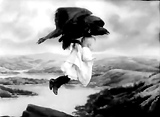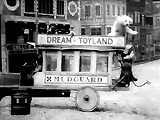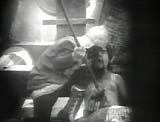
|
Special Effects (F/X) - Milestones in Film 1906-1920 |

|
Dream of a Rarebit Fiend (1906) Edwin S. Porter directed this seven-minute fantasy film using trick photography. [The name was based on a Winsor McCay newspaper comic strip of the same name - McCay served as the film's writer.] It was the Edison Manufacturing Company's most popular film of the year. The short tale told of a man (Jack Brawn) who ate a meal of Welsh rarebit along with excessive amounts of alcohol. On his way home while passing a streetlight, reality became surrealistic for him as the alcohol took effect. At his home as he tried to sleep, three little devil characters appeared at the head of his bed, and his bed floated up and out the window and traveled over the city. |

|

|
Humorous Phases of Funny Faces
(1906) In the best-known early sequence, a cartoonist's line (or chalk) drawings of the caricaturized faces of a man and a woman were 'animated' (or came to life) on a blackboard. The two faces smiled and winked (and rolled their eyes), and the cigar-smoking man blew a billowing cloud of smoke in the lady's face. When that image was erased, the sideways outline of a portly bowler-hatted gentleman with umbrella was drawn. He twirled his umbrella into the air, and doffed his hat. In the final segment, a circus clown performed tricks with his hat and then with a small poodle dog including having him jump through a hoop. |
  
|

|
The Haunted Hotel, or Strange Adventures of a Traveler (1907) Produced by the American Vitagraph Company and released in the US in 1907, this live-action and stop-motion animation short film was directed by J. Stuart Blackton. It told about a tired, long-nosed traveler arriving at a hotel, where invisible ghosts performed the various menial tasks. In one astonishing and sensational trick sequence of stop-motion animation using three-dimensional objects, a table was set "by invisible hands," a loaf of bread was sliced, coffee was poured into a cup (and a cup of sugar spooned out added tablespoons). A small clown jumped out of a large milk urn. And then the traveler reached for his napkin, which danced away from him. In the conclusion when he went to sleep, a demon grabbed the traveler. |
  
|
Rescued From an Eagle's Nest (1907/08) Richard Murphy created a mechanical eagle for this short film directed by J. Searle Dawley (an early Edison production with future director D. W. Griffith in his first major screen role as the lumberjack father). In the opening scene, an eagle with movable wings (from a taxidermist) swooped down and kidnapped a baby that was playing in the dirt outside a family's cabin. The image was a composite shot of a painted background, the stuffed model eagle on a wire, and a real baby. The heroic woodsman father scaled down a steep rock cliff to battle the eagle and rescue his infant child. |
  
|
|

|
The "Teddy" Bears (1907) Edwin Porter directed this short 13-minute film (a variation on the Goldilocks and the three bears story) - it was one of the earliest all stop-motion or stop-frame animation films and took approximately 56 hours to animate just one minute of film. The narrative portion of the film told about how three anthropomorphic bears pursued Goldilocks across snowy terrain until a hunter (a satire on "Teddy" Roosevelt - the nation's President at the time) killed the two larger bears, but captured the third baby bear (based upon a true story about how TR refused to shoot a bear cub). There was also an opening animated sequence of six stuffed 'dancing' teddy bears of varying sizes coming to life. |

|

|
A Dream of Toyland (1907 or 1908, UK) (aka Dreams of Toyland, or In the Land of Nod) As animation forms continued to be explored, director Arthur Melbourne Cooper animated real toys (puppet animation) in this short. A young boy went to a toy shop with his mother, then returned home with many packages of toys that were purchased, and went to sleep. He dreamed that his toys (cars, teddy bears, policeman, monkey, and horse) came to life to dance, play, chase each other, and fight in the street!
|
 
|

|
The Adventures of Dollie (1908) This was the first one-reel film directed by D. W. Griffith (in the same year that he started as a director at American Mutoscope and Biograph Company in New York City). It was released and debuted in New York. Griffith would go on to direct 450 one-reel films for Biograph in the next five years, developing many innovative techniques. It told about an idyllic summertime outing of a family with a daughter in a bright-white dress named Dollie (Gladys Egan), who then faced peril. She was kidnapped by gypsies and placed in a large barrel - which fell into a river when precariously placed at the back of their schooner-wagon, and soon the barrel (with Dollie inside) drifted toward a menacing waterfall. The barrel cascaded over the falls, but Dollie survived when the round barrel was discovered by a boy fishing by the side of the river. Its top was opened and Dollie was rescued, and reunited with her mother. |
 
|

|
Fantasmagorie (1908, Fr.) Emile Cohl's animated short film was considered the first fully animated film. It consisted solely of simple line drawings that blended, transformed or morphed from one image into another. In one early live-action sequence, the animator's hand entered the scene to draw a clown-like stick figure. The dream-like film was created by placing each drawing on an illuminated glass plate and then tracing the next drawing - with variations - on top of it until the animator had about 700 drawings, all of which were double-exposed to make the film run longer. The black lines on white paper were printed in negative reverse, making it appear as if the action was on a blackboard. |
 
|

|
The Conquest of the North Pole (1912, Fr.) (aka À La Conquête du Pôle, or Die Entdeckung des Nordpols) This was one of the last of French filmmaker Georges Melies' output of hundreds of short films, although this one was longer at about 30 minutes. It marked the end of his career as a film-maker, although this sci-fi adventure had many special effects. However, by this time, none of them were entirely novel. It was another of his 'trick' films, similar to his earlier landmark A Trip to the Moon (1902) - but this one featured a trip to the North Pole. Only a few years earlier, Robert E. Peary and his team of explorers had set foot on the North Pole in April of 1909. Melies' film contained the special effect of a large puppet ice-man figure or frost giant called the Giant of the Snows - in reality, it was a large marionette operated by about a dozen individuals. The explorers needed to frighten the frost giant with cannon-fire. Melies played the part of Le Professeur Mabouloff / ou Maboul. |

|

|
Cabiria (1914, It.) This box-office success was a black/white 180-minute silent epic directed by Giovanni Pastrone. It was a landmark film - an early example of monumental epic film-making with thousands of extras, large sets and spectacular stunts. It laid the pattern and groundwork for future big-budget feature-length films (by the likes of D.W. Griffith and Cecil B. DeMille). The film inspired D.W. Griffith to make his own epic Intolerance (1916). Its story of 3rd century BC Ancient Rome included sequences of the eruption of Mt. Etna, and Hannibal's crossing of the Alps with elephants (with an early example of tracking shots). The landmark film was shot on location in North Africa, Sicily and the Italian Alps, and reportedly contained the first use of trucking shots (which became known as 'Cabiria' movements). |
 
|

|
Gertie the Dinosaur (1914)
(aka Gertie) In the animation, McCay introduced the brontosaurus dinosaur, who then walked out onto the screen. Appearing to 'interact' with Gertie, McCay directed his creation from stage right - telling Gertie to do a little dance, take a bow, and raise her right foot, to the audience's astonishment. Then, McCay 'walked into' the animation by disappearing behind the screen, and then appeared in cartoon form as a 'live action figure' on the screen to ride on the back of the dinosaur into the distance. It was the earliest example of combined 'live action' and animation -- and the first "interactive" animated cartoon, made using the single-frame method. Single images projected at a high volume of frames per second created the 'animated' effect. The film's advertisement called it the "Greatest Animal Act in the World." |
 
|
The Miser's Reversion (1914) (aka The Miser's Conversion) This was the first film to depict a screen transformation by using a series of dissolves with footage of the character's different stages of makeup, rather than a single jump-cut. This was later used to great effect in many films including Dr. Jekyll and Mr. Hyde (1931) and The Wolfman (1941) In the film, the title character 75 year-old miser John Grisley (Sidney Bracey), was obsessed with Darwin's theory and idea of evolution. He was specifically interested in having his daughter May (Adele Ray) only marry a very rich man. During a demonstration in a convention hall, an Elixir of Eternal Youth was being tested by some Hindus. The rejuvenation serum was tested on the miser sitting on stage - and he was transformed into a 40 year-old man with just a few drops. To intensify the effect, the miser grabbed the bottle of serum and drank its entire contents - and reverted into an ape. He was unable to convince his daughter and her sweetheart Jack (Harry Benham) that he was the father, until he showed them an identifiable tattoo. He was restored back to his normal self through their help, and in return, gave all of his money to the young couple. |

The Miser Converted Into an Ape |
|

|
D. W. Griffith's pacifistic epic contained some of the earliest in camera or make-up/special effects - such as the sword beheading of one Babylonian soldier, and the realistic chest-stabbing of another opponent. |
 
|
El Apóstol (1917, Argentina) (aka The Apostle) Italian-Argentinian writer/director Quirino Cristiani's 70-minute long film (a lost film) was the world's first animated, stop-motion feature film (using a process of cut-outs). The only surviving elements of the silent, black and white political satire (of then President Hipolito Yrigoyen) were a few character sketches or designs. |

|
|
The Gulf Between (1917-1918) This film was the first feature-length motion picture in two-strip Technicolor produced in the US. It was also the third feature-length color movie. It is considered a lost film, with only a few frames surviving. |

|
|

|
The Sinking of the Lusitania (1918) Early cartoonist and animator Winsor McCay's 12-minute propagandistic, documentary-style The Sinking of the Lusitania, was an animation landmark. It was the first serious re-enactment of an historical event, and one of the earliest films to utilize cel animation. The torpedoing of the RMS Lusitania by a German U-boat on May 7, 1915 resulted in the loss of almost 2,000 passengers. |
 
|
The Debut of Thomas Katt (1920) Producer John Randolph Bray's (and Bray Picture Corporation's) The Debut of Thomas Katt (or Kat or Cat) was the first color (2-color process) cartoon, using the expensive Brewster Natural Color Process (a 2-emulsion color process), an unsuccessful precursor of Technicolor. In the short film, the plot involved a kitten encountering a rat for the first time, rather than the mice it was used to. This was the first animated short genuinely made in color using color film. However, some sources have claimed that the Natural Colour Kinematograph Company's In Gollywog Land (1912, UK) was the earliest, using Kinemacolor. |
||